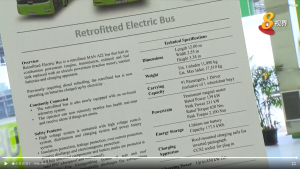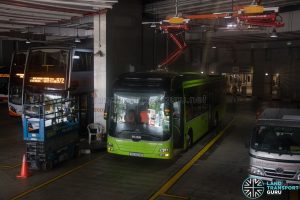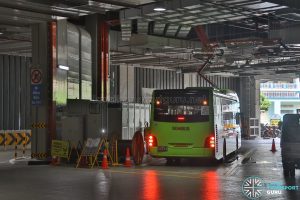| ST Engineering Retrofitted Electric Bus (MAN A22) | |
|
Clik here to view.  |
|
| Manufacturer | MAN (chassis); ST Engineering / Linkker (drivetrain) |
| Bodywork | MAN Lion’s City Hybrid (Gemilang Coachworks) |
| Years in operation | 2020 — |
| Operators | TBA |
| Technical Data | |
| Length | 12 metre |
| Motor | Permanent Magnet Motor |
| Battery | 177.5 kWh Li-ion |
| Accessibility | Low Floor |
| Emission Standard | Zero tailpipe emissions |
The ST Engineering Retrofitted Electric Bus is the product of an electric bus conversion project undertaken by ST Engineering and Linkker on an existing MAN A22 (Euro V) bus. The low-floor single-deck city bus is widely operated in Singapore in Euro V and Euro VI variants.
Only one unit of this bus has been produced.
A total of 734 MAN A22 buses were brought in by SMRT Buses between 2010 and 2016, built to Euro V specifications. Further purchases of the Euro VI variant were delivered with a different style of bodywork. Under the Bus Contracting Model, MAN NL323F buses were also leased to Tower Transit, SBS Transit and Go-Ahead Singapore. All units are bodied by Gemilang Coachworks of Malaysia.
Another MAN A22 concept bus, the 3-door MAN Lion’s City SD Concept Bus (now LTA Smart Bus), was also a project undertaken by ST Engineering.
Main article: MAN A22
Technical Information:
ST Engineering’s 2017 Annual Report first revealed that the company was awarded an LTA tender to retrofit a single-deck electric MAN bus as a proof-of-concept. The tender is believed to be a closed tender, with LTA not making any references to the tender within its annual reports published in that period.
The retrofit project was done in cooperation with Finnish electric bus manufacturer Linkker, who ST Engineering is working with to bring its electric bus technologies into the Singapore market. ST Engineering is currently an authorised distributor of Linkker right-hand drive electric buses in the Asia-Pacific region, with a partnership inked in 2017 and Linkker cited as an “Original Equipment Manufacturer (OEM)”.
As for the bus, SMB3075A was selected for the conversion. The bus is a former Euro V MAN NL323F bus (Chassis no.: WMAA22ZZXD7001880) bodied with the MAN Lion’s City Hybrid bodywork assembled by Gemilang Coachworks. First registered to SMRT Buses on 2 September 2013, it was removed from revenue service from February 2018 and laid up, which indicated that the bus would be taken out of service for a prolonged period of time (during which it is exempted from road tax). It bore SMRT’s beige livery at launch before being repainted to SMRT’s pixel livery.
Image may be NSFW.Clik here to view.
 Image may be NSFW.
Image may be NSFW.Clik here to view.

SMB3075A was shipped from Singapore to Turku (Finland) for the modification work, where it was retrofitted with Linkker’s own electric drivetrain, which is currently supplied by Danish manufacturer Danfoss. Apart from selling whole buses, Linkker also manufacturers retrofit kits for other bus bodies, which mainly consists of the electric drivetrain and other peripheral equipment.
Apart from this project, ST Engineering (Land Systems) is also working with Linkker on various projects such as the STE-Linkker Autonomous Electric Bus, and the fulfillment of 20 single-deck electric buses procured by LTA expected for delivery in 2020. The company was one of three successful tenderers, the others being BYD and Yutong, who will deliver a combined 60 electric buses between 2019 and 2020.
ST Engineering Retrofitted Electric Bus
One unit of the ST Engineering Retrofitted Electric Bus has been produced and re-registered as SG3100M in October/November 2019. As of 11 November 2019, the bus is still registered under SMRT Buses Ltd (former operator of SMB3075A) with a non-user lay-up status.
Electric drivetrain components are supplied by Linkker (branded as LinkDrive).
| Basic Technical Specifications | |
| Driveline | Linkker LinkDrive electric driveline |
| Electric Motor | Permanent Magnet Motor Rated power/torque of 139 kW/828 Nm | Peak power/torque of 231 kW/2100Nm Likely from the Danfoss Editron model line (unconfirmed) |
| Battery | 177.5 kWh Lithium-ion batteries Charged via roof-mounted charging rails (for overhead pantograph charger) with secondary CCS2 plug-in charging capability Up to 450 kW DC charging power |
| Bodywork | MAN Lion’s City Hybrid (Built under license by Gemilang Coachworks) ‘EcoRange’ aluminium bus body, full-low-floor layout |
| EDS | Mobitec MobiLED, orange LED matrix design |
| Passenger Capacity | 35 seating + 56 standing = 91 total |
| Additional Specifications | 110–120 km range, depending on operating scenarios |
According to specifications released by LTA, a 10-minute charge stores up to 75kWh of energy in the bus’ batteries, which is sufficient for up to 48km of range. Specification sheets indicate a full recharge time of 30 minutes, and between 110–120 km of range on a full charge, depending on operating scenarios.
Image may be NSFW.Clik here to view.
 Image may be NSFW.
Image may be NSFW.Clik here to view.
 Image may be NSFW.
Image may be NSFW.Clik here to view.
 Image may be NSFW.
Image may be NSFW.Clik here to view.
 Image may be NSFW.
Image may be NSFW.Clik here to view.
 Image may be NSFW.
Image may be NSFW.Clik here to view.
 Image may be NSFW.
Image may be NSFW.Clik here to view.
 Image may be NSFW.
Image may be NSFW.Clik here to view.

As part of the retrofitting works, the centre pole at the entrance has been removed to allow easier access for parents with open strollers.
Opportunity charging
Based around the concept of Opportunity charging, the ST Engineering Retrofitted Electric Bus is charged at the terminus of a bus route, where charging points (typically overhead charging) are erected. The bus is sufficiently recharged in a short amount of time (usually several minutes) before the bus continues on its next trip.
Clik here to view.

With fewer batteries required per bus, its advantages translate to a more spacious bus interior, lower environmental cost of battery production, and lower electricity consumption through reduced vehicle weight. Its disadvantages include the lack of deployment flexibility (on non-infrastructure-equipped routes) and the possible impact on bus operations should a charging station break down, and some redundancy is thus required, such as installing multiple chargers at terminating points.
Currently, efforts are focused on expanding the use of opportunity charging on suitable routes and the adoption of similar charging infrastructure between bus manufacturers, allowing multiple bus models to use the same charger.
The Opportunity Charging approach is favoured by European bus manufacturers. Conventional, depot-charged buses carry a large number of batteries on every bus to achieve sufficient operating range over a day’s worth of revenue service, and is the approach preferred by Chinese bus manufacturers.
Overhead pantograph
The ST Engineering Retrofitted Electric Bus will be charged via overheard pantograph, based on the opportunity charging (OppCharge) platform.
Clik here to view.

OppCharge is an open and competition-neutral interface seeking to accelerate the adoption of electric buses by being compatible with multiple bus manufacturers, hence offering operators choice and flexibility of buses without the need to modify existing charging infrastructure. These overhead pylon chargers with extendable pantographs are usually installed at the end stops of bus routes, allowing buses to quickly receive a full charge in-between trips.
Charging is fully automatic and secured by a two-way WiFi communication sequence. The driver gets a clear indication in order to stop within the specified ± 200 mm from the reference point. The charging sequence is started by activating the parking brake, and the driver can interrupt it at any time.
Swiss-Swedish engineering group ABB supplied four 450 kW chargers with installation, civil works, project management and commissioning. These chargers would allow the electric buses to be quickly recharged in less than ten minutes at key bus interchanges with an automated rooftop connection.
A similar overhead charger was installed at Cleantech Park in support of the NTU-LTA-Volvo Autonomous Bus Trial. The Volvo 7900 Electric bus participating in the trial is OppCharge-compatible and is recharged with the ABB HVC 300P fast-charge system, which delivers 300 kW DC power.
Image may be NSFW.Clik here to view.
 Image may be NSFW.
Image may be NSFW.Clik here to view.

Two overhead pantograph chargers were each installed at Bukit Panjang Integrated Transport Hub and Bedok Integrated Transport Hub.
Image may be NSFW.Clik here to view.
 Image may be NSFW.
Image may be NSFW.Clik here to view.
 Image may be NSFW.
Image may be NSFW.Clik here to view.
 Image may be NSFW.
Image may be NSFW.Clik here to view.

External Links & References:
Back to Bus Models
Back to Bus Articles